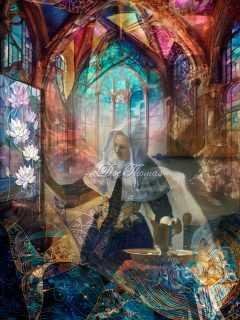Veins of Porcelain: The Sacred Vessel
Veins of Porcelain: The Sacred Vessel transforms Vermeer’s Woman with a Water Jug into a cosmic liturgy. The woman stands within a radiant cathedral of glass and light, her simple act transfigured into ritual. Iridescent windows shimmer above, while lotus blossoms and golden waves swirl beneath her hands. The jug, now sacred, pours more than water—it offers spiritual memory. Vermeer’s gentle light becomes divine illumination, and every color glows with reverence. With stained glass skies, cosmic robes, and an aura of inner peace, this reimagination honors the holy in the everyday—the divine in the mundane, the miracle in stillness.
Please see Below for Details…
Hotline Order:
Mon - Fri: 07AM - 06PM
404-872-4663
Veins of Porcelain: The Sacred Vessel reimagines Johannes Vermeer’s Woman with a Water Jug as a celestial ritual within an illuminated cathedral of light and transformation. The domestic act of pouring water becomes a devotional gesture, and the woman is elevated from her quiet corner of 17th-century Delft into a luminous sanctuary that fuses sacred space, alchemical symbolism, and cosmic resonance. Here, the jug is no longer just a container—it is a chalice of renewal, a key to an inner sanctum where ritual and silence weave miracles.
In this surreal reinterpretation, the interior of Vermeer’s room morphs into a dreamlike cathedral. Gothic arches bloom above her, their stained-glass windows pulsing with iridescent blues, violets, and golden pinks. They do not simply reflect light—they radiate it. The woman’s veil glows with soft translucence, catching the spectrum of these divine windows as if touched by angels. Light no longer enters from a single open window—it descends from everywhere, kaleidoscopic and mystical, wrapping her hands, her jug, her table in spiritual hues. Her dress, once in modest Delft blue, now sways with waves of navy stitched in cosmic lace, patterned with stars and lotus flowers—the sacred symbols of enlightenment and flow.
The left of the composition introduces a cascade of lotus blooms, rising in gradients of ivory and lavender, referencing both rebirth and the silent strength of feminine purity. Meanwhile, intricate filigree and glowing tendrils weave through the floor, tracing out currents of water and energy, symbolizing the motion between inner and outer worlds. Behind her, stained glass arches bend into infinity—temples within temples—echoing the sacred architecture of both earthly cathedrals and ethereal mindscapes.
As the artist, I approached Vermeer’s serene woman not as a passive domestic figure, but as a keeper of unseen rites. I imagined her as a priestess caught in the quiet hour between dark and light, pouring not water, but memory, ancestry, stillness. The water jug becomes the axis mundi—a link between heaven and earth. Her gaze, focused yet tender, suggests not distraction but profound inwardness. I wanted to paint the moment not as it looks, but as it feels when silence is holy, when intention glows brighter than gold.
Color became my first language of transformation. The cathedral windows bloom in purples and aquas, denoting wisdom and intuition. Deep sapphire folds in her robe ground her in truth and mystery, while gold thread winds around her, speaking of spiritual illumination. The jug gleams with a sacred metallic shimmer, silver-gold and liquid in motion, reflecting the entire palette of the room like a crystal holding a spell. The table and its objects—basin, mirror, glass—float slightly, suspended between physicality and spirit. They are no longer items of function, but relics, each holding symbolic weight: the mirror of self, the basin of purification, the jug of life’s quiet offering.
Pollock’s influence enters not through his chaos, but through his energy. His spirit flows in the curved ornamental lines and the surreal breaking of dimensional space. His abstraction is here translated into a kind of spiritual choreography—the swirling arabesques that dance around her, the energetic fields that pulse through every object. These elements honor his signature energy while cloaking it in reverence and inner rhythm.
The entire piece lives between dualities: stillness and movement, sacred and mundane, interior and cosmic. The woman’s action remains as Vermeer painted it—poised, delicate, humble. But the world around her testifies to something more. She is not simply filling a basin; she is performing a private sacrament that reshapes the air. Her water is not just hydration—it is baptism, initiation, reflection. She is a vessel pouring from a vessel.
Veins of Porcelain: The Sacred Vessel is about reverence. It is about the power of the unnoticed act. In a world where miracles are often loud, this composition asks the viewer to kneel beside her and feel the divine hum of stillness. It is a reminder that grace does not shout. Sometimes, it simply pours.
Add your review
Your email address will not be published. Required fields are marked *
Please login to write review!
Looks like there are no reviews yet.










